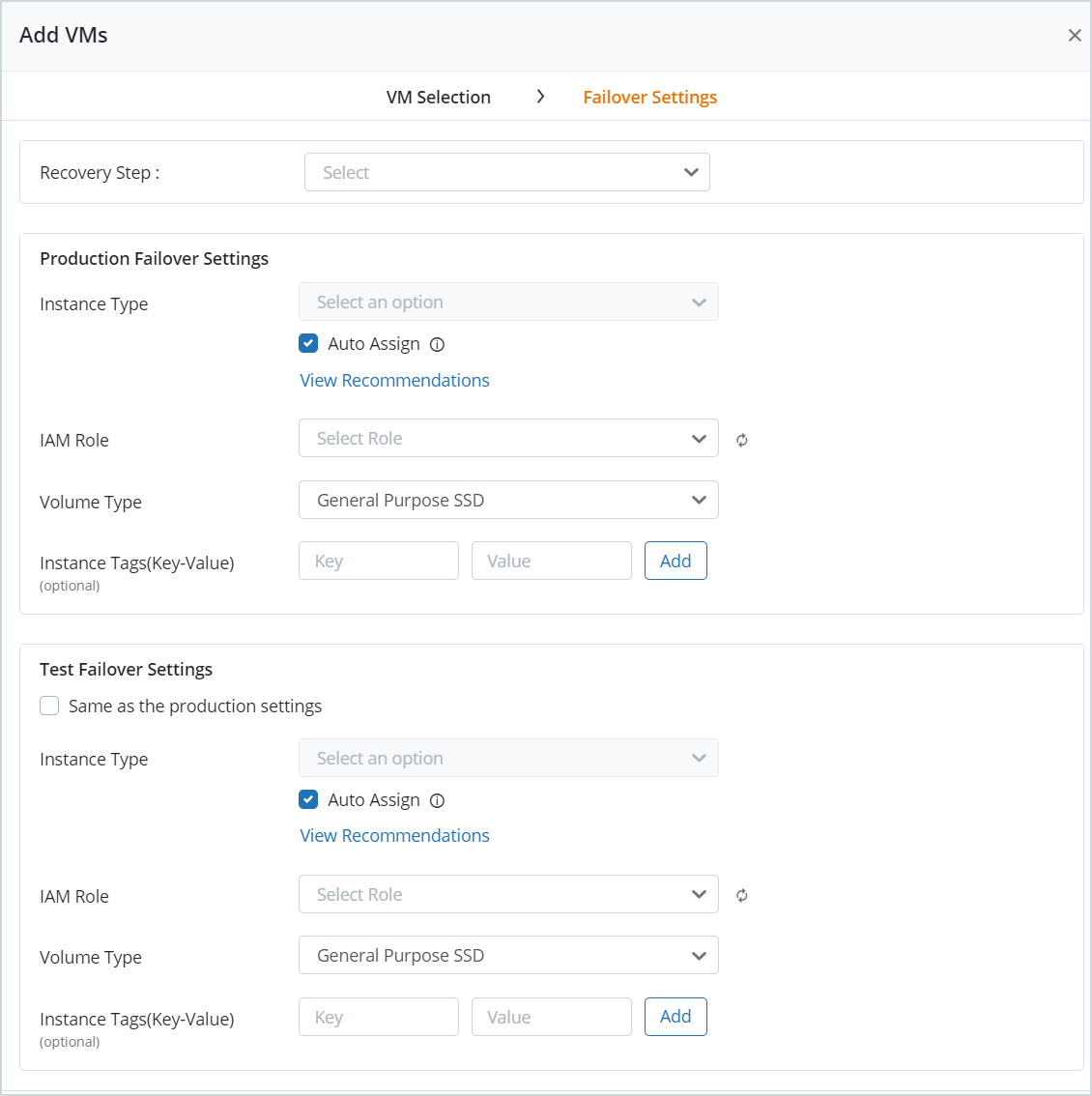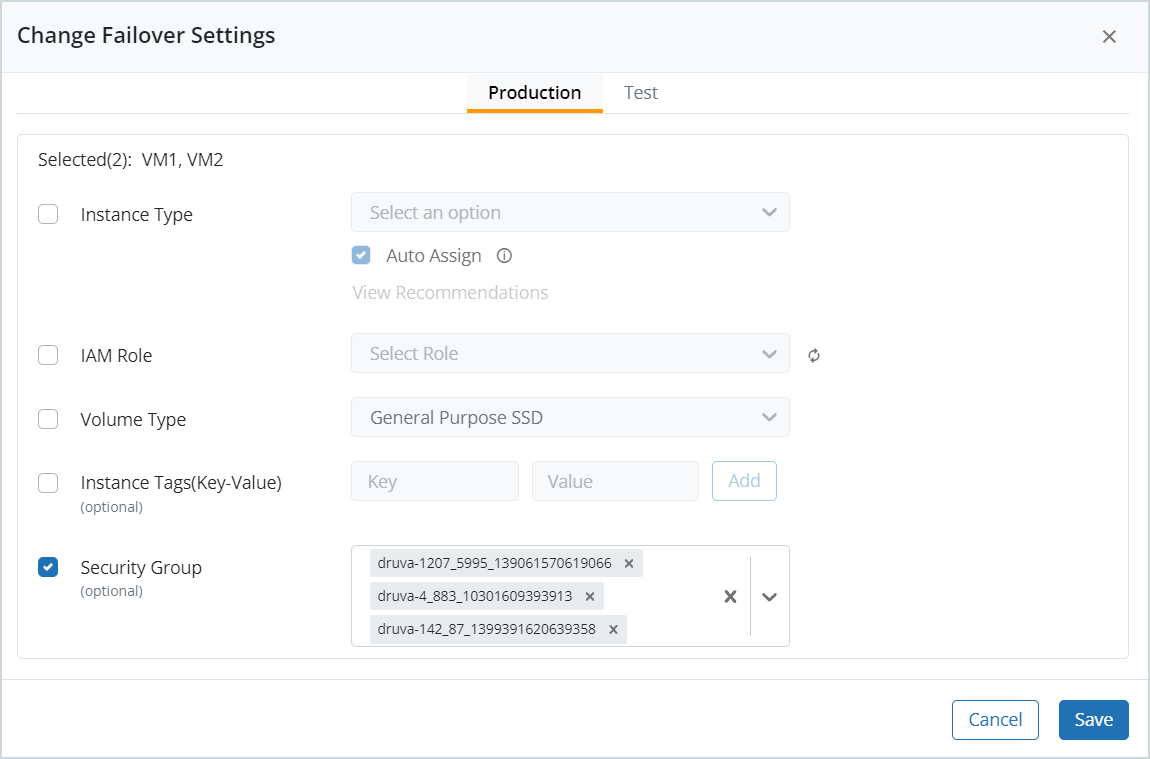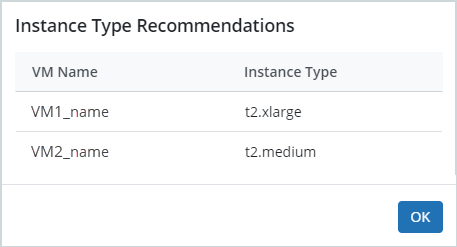Manage virtual machines
Enterprise Workloads Editions
❌ Business| ✅ Enterprise (Purchase Separately) | ✅ Elite
Overview
Druva allows you to add virtual machines from
To view virtual machines configured for disaster recovery
- Log in to the Management Console.
- On the menu bar, click the drop-down next to All Organizations, and select the required organization from the drop-down list.
- Click Disaster Recovery. The Disaster Recovery page opens.
-
Select a DR plan from the DR plan dropdown list.
-
In the left navigation bar, click Virtual Machines.
-
View the VM details. See, Virtual machine details.
-
Select the operation you want to perform. See, Operations for virtual machine management.
Virtual machine details
The following details of the VMs that are configured are disaster recovery is available.
| Field | Description |
|---|---|
| VM Name | Name of the virtual machine. |
| DR Enabled | Indicates whether new DR Restore jobs would be created for that VM. Note: If you have a DR copy, you can trigger a failover job anytime, irrespective of whether or not DR is enabled for a VM. |
| Last backup status | When was the last backup run and its status. |
| Last DR Restore Status | When did the last DR restore job complete and its status. |
| RPA | Recovery Actual Point (RPA) represents the time elapsed since the last successful recovery point of the VM that is available for failover. See, Managing Recovery Point Actual (RPA). |
| Failover settings | Hover to view the details of the test and production failover settings. The Instance Type column shows Auto Assigned if you chose to let Druva automatically assign an instance type for the production or test failovers of the VM. You can also see the security groups selected for the production and test failover settings. |
| Failover Checks - Environment |
Displays the status of the environmental failover checks with details on the cause and how to resolve it. For more information, see DR failover checks - environment. |
| Failover Checks - Guest OS | Displays the status of the guest OS failover checks statuses. For more information, see DR failover checks - Guest OS |
Operations for virtual machine management
You can perform the following operations to manage your virtual machines for disaster recovery.
| Operation | Description |
|---|---|
| Change Failover settings |
You can update the production and test failover settings. |
| Add VM |
You can add virtual machines from multiple registered vCenters/ESXi hosts and administrative groups to an exisitng DR plan. You can also configure the failover settings while you add the VMs to the DR plan. You can add only those VMs that are configured for backup by Druva. |
| Update DR copy | Druva regularly updates the DR copy of the backed up virtual machines based on the schedule defined in the DR plan set during configuration. In addition to the scheduled DR copy update, you can manually update the DR copy at any time. |
| Update Credentials | You can assign credentials to the virtual machines that are part of the DR Plan. Credentials are required to perform prerequisite checks during the VM backup. Prerequisite checks proactively identify issues that could cause failures during failovers. You can also update credentials assigned to virtual machines. |
| Enable DR | You can enable disaster recovery for a virtual machine associated with a DR plan to recover the backup data in the event of a disaster. After enabling, the DR copies are updated for the virtual machines and you can failover virtual machines using these DR copies. |
| Disable DR | You can disable the disaster recovery service for a virtual machine associated with a DR plan at any time. After disabling, the DR copies not updated for the virtual machines. However, you can failover the virtual machine using the last DR copy created before the DR was disabled. The DR copy updates will resume only after you enable the service on the virtual machine. |
| Remove VM | You can unconfigure virtual machines from the configured DR plan. When you unconfigure virtual machines from a DR plan, the assets created during the previous DR copies get deleted. Failure of deletion of assets generates an alert containing assets details. |
Considerations for adding virtual machines to the DR plan
Before adding a virtual machine to a DR plan, you must consider the following points:
- You can add only those virtual machines to a DR plan for which the storage region for backup is the same as the region specified in the DR plan.
- You cannot add the same virtual machine to multiple DR plans.
- Once you add a virtual machine to a DR plan, DR copies for that virtual machine is created periodically as per the schedule specified in the DR plan.
- When adding a virtual machine to a DR plan, Druva sets the virtual machine-specific failover settings for launching an instance with its DR copy to the predefined default values. You can edit these settings later.
To add virtual machines to an existing DR plan
- Log in to the Management Console.
-
On the menu bar, click the dropdown next to All Organizations, and select the required organization.
-
On the menu bar click Disaster Recovery.
-
On the DR Plans page, click the DR plan to which you want to add virtual machines. Alternatively, you can select a DR plan from the Select DR plan dropdown list.
-
In the left navigation bar, click Virtual Machines, and click Add VM.
- The VM Selection tab of the Add VMs dialog box displays a list of the configured virtual machines and details, such as the registered vCenter/ESXi hosts, administrative groups, and Guest OS Credentials. Select the virtual machines that you want to add to the DR plan.
Note: The Add VMs page displays only those virtual machines which are configured for backup.
-
The Guest OS credentials column displays the credentials assigned to the virtual machines. The credentials displayed here were assigned to the VMs from the All Virtual Machines page under Protect > VMware. A yellow exclamation mark next to the credential in the Guest OS Credential column signifies that the credentials for the associated VM are invalid. If there is no icon next to the credential, then it means that either:
- The credential is valid, or
- The credential validation information is not available, or
- The credential was assigned to the VM after the VMware application discovery job finished. The VMware application discovery job runs every 24 hours. It validates the credentials and stores the application discovery and credential validation status.
-
The Prerequisite Check section lets you assign credentials to VMs selected under the Source VM section. Credentials are required for the DR failover checks - Guest OS that run while the backup of a VM is in progress. You can either select pre-existing credentials from the drop-down or click New Credentials to create and assign new credentials. See Adding a new credential for field descriptions. The newly created credentials are stored securely in the Credential Store.
The credentials assigned in this dialog box will show up under the Guest OS Credentials column on the All Virtual Machines page under Protect > VMware. These credentials will be used to run DR prerequisite checks the next time a backup of the VM is in progress.
Note: If a VM already has credentials assigned to it, selecting the VM and assigning it credentials from this dialog box will override the existing credentials. -
Click Next and update the failover settings for the virtual machines you want to add.
To add failover settings for the newly added VMs
- From the Recovery Step dropdown list, select the recovery step for the VM to be included in the recovery workflow.
- Update the Production Failover and Test Failover settings.
Select Same as the production settings to use production settings for test failovers settings.
- Click Finish.
Filter Virtual Machines
You can filter virtual machines in a DR plan by the status of failover checks (Guest OS and Environment) and the VPC that the virtual machines belong to. Filtering the virtual machines by the status of the failover checks helps you preemptively correct issues that could cause failovers to fail. For more information, see DR failover checks - Guest OS and DR Failover Checks - Environment.
You can change the security groups for more than one virtual machine at a time. However, all the selected virtual machines must be a part of the same VPC. Use the VPC filter on the Virtual Machines page of a DR plan to filter the virtual machines list by VPC and then update the security group settings for all the virtual machines that belong to the same VPC.

Change security group for multiple virtual machines
You can change the security group for multiple virtual machines at a time, provided all the selected machines belong to the same VPC. Use the VPC filter to get all the virtual machines that belong to the same VPC.
Procedure
- Select a DR plan that has VMs whose security group you need to change.
- Navigate to the Virtual Machines page of the selected DR plan.
- Filter the virtual machines in the plan by a specific VPC. All the VMs that belong to a specific VPC are displayed.
- Select one or more virtual machines whose security group you need to change and click Change Failover Settings.
- In the Change Failover Settings dialog box, select the Security Group checkbox and select one or more security groups to the selected VMs.
- Note: The Security Group checkbox is disabled if the selected virtual machines belong to different VPCs. To change security groups of VMs belonging to different VPCs, filter the Virtual Machines listing by VPCs and change the security group settings in bulk. Alternatively, change the security groups one VM at a time.
- Click Save.




